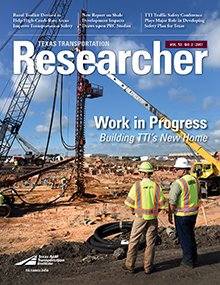Half of all fatal crashes in Texas occur on rural roadways. Researchers with the Texas A&M Transportation Institute (TTI) have identified those areas of the state with the highest crash rates and devised a plan that focuses on solving their specific issues, despite limited resources.

“This is a targeted, evidence-based, systematic approach that not only provides a detailed analysis of a community’s crash problem, but also helps residents overcome their biggest obstacles when it comes to making their roadways safer,” says Senior Research Scientist Michael Manser, leader of TTI’s Human Factors Team in the Center for Transportation Safety (CTS). “Most rural areas simply don’t have the funding or the staff to address traffic safety issues and may not have the time to understand the steps required to address their issues.”
With project funding from the Texas Department of State Health Services (DSHS), CTS researchers created a simple, understandable and easy-to-use Rural Toolkit for Transportation Safety that provides a framework for the steps that a community can work through to address its transportation safety issues.
The toolkit combines the successful elements of the National Highway Transportation Safety Administration Safe Communities and the Federal Highway Administration Local Road Safety Plan approaches. Communities interested in addressing their transportation safety needs can now work through the toolkit stages to identify their safety issues, develop goals and associated strategies, implement the strategies, and conduct an evaluation.
The toolkit provides simplified information from previous approaches, including the steps that require input from outside sources. An area that is critically important — but many times beyond the reach of a community — is the need to obtain and analyze transportation safety data and to understand local transportation safety needs. The toolkit accounts for this by allowing project team members to serve as a source for much-needed data and statistical analyses.

For example, TTI first analyzed crash data across rural Texas according to geographic areas defined by Texas independent school districts. A four-district area clustered in the Texas Hill Country was found to have a disturbing problem — motorcycles were involved in a large percentage of its crashes, with a high number of serious upper-body injuries.
“The analysis of the linked data from Texas’ Crash Record Information System, emergency medical services and local hospitals gave us a detailed picture of the crash characteristics, roadway features, causes of the crashes — including whether alcohol or distraction was involved — and injury severity,” says TTI Crash Analysis Group Team Leader Eva Shipp. “Of the top 10 rural areas examined, four are in an area northwest of San Antonio with the greatest risk for severe crashes.”
The areas with the higher frequencies of severe crashes include roadways in Medina, Leakey, Hunt and Utopia, Texas. The analysis conducted by Shipp showed that 30 percent of all the crashes involved motorcycles, 56 percent of all the injuries were classified as severe, and emergency response time was 10 minutes longer than in other rural school district regions (likely due to the long distances EMS must travel).
Manser is now working with stakeholders in the four-district region as part of a pilot project that use the newly designed toolkit. Ideally, a stakeholder group will be formed to examine specific transportation safety issues in their region. The stakeholder group can then follow the multi-stage process outlined in the toolkit to address those problems identified from the statistics.
The TTI/DSHS team will provide guidance and resources, including information about specific safety countermeasures (e.g., increased law enforcement presence on high-crash roadways, guardrail extensions, and implementation of lower speed limits).
“The collaboration between the DSHS Injury Epidemiology and Surveillance Branch and TTI to produce the Rural Toolkit for Transportation Safety exemplifies the public health advances that can be achieved by working together to benefit local communities,” says Dan Dao, team leader with DSHS. “It is exciting to see the data collected by our program used to inform public health and prevention efforts to improve the lives of Texans.”

